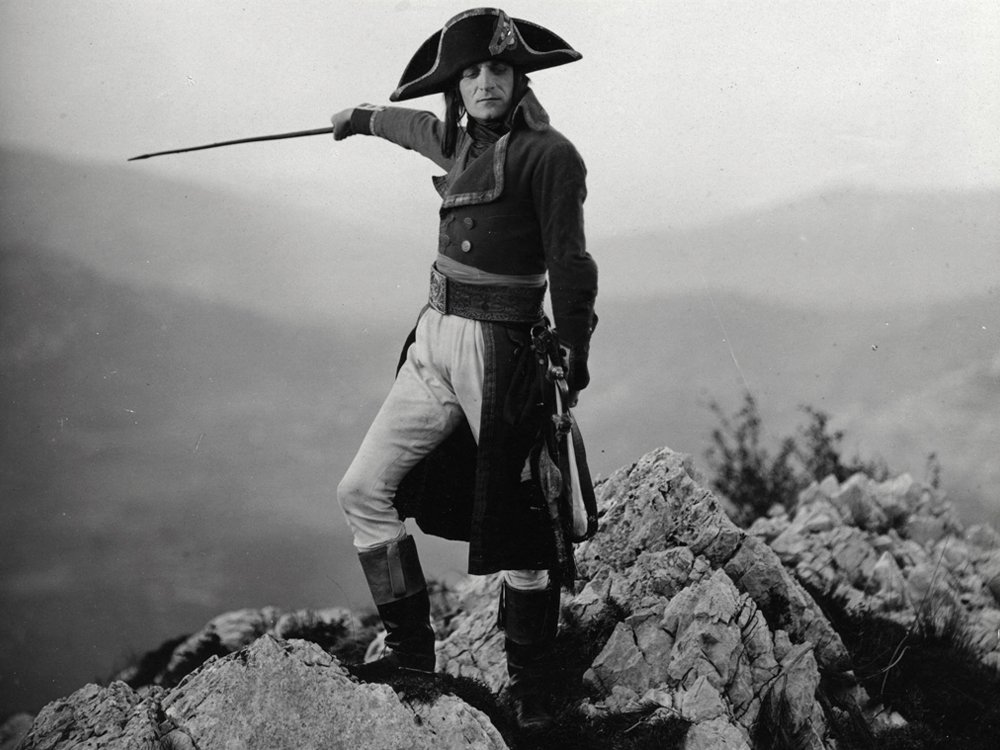From Abel Gance’s “Napolean" (1902).
By André Crous
Napoléon, by French filmmaker Abel Gance, is an experimental epic that has achieved the status of legend, with good reason. The story of the young Napoleon Bonaparte (the film charts his development from school boy till the age of 27, when he successfully invaded Italy) is presented as a visual feast that keeps churning out scene after scene, the one as breathtaking as the next. The entire film is accompanied by a masterful orchestral score composed by Carmine Coppola that deftly integrates melodies from a few other works, including, among others, the French national anthem, “La Marseillaise”, and Hector Berlioz’s “Symphonie Fantastique”. The 2000 restoration of the film has a score by Carl Davis, which has been performed at various public screenings of the film in the past few years, most notably at the Royal Festival Hall in London.
The film is a cinematic tour de force and contains a multitude of memorable scenes, from the snowball fight at Napoleon’s school and a scene with his pet eagle to the scene where crowds of people learn the new French national anthem, a double storm scene and the climactic tricolour triptych that makes visible Napoleon’s desires for himself and his country. At one point, during a chase on horseback across the Corsican countryside, Gance even fixes his camera to a saddle in order to give us Napoleon’s point of view.
These are all scenes that one can talk about extensively, for they demonstrate the skill of the director and the joy he found in telling the adventurous story of Napoleon’s rise to power. I was incredibly moved when the song’s composer, Roget de Lisle, sang “La Marseillaise”: The soundtrack had already been hinting at the gorgeous melody for a while, since Danton, Marat and Robespierre had received word of the composer’s arrival, and when de Lisle finally performs his work, the effect is overwhelming exhilaration. The combination of the music itself, the passion on de Lisle’s face, the emotion on the listeners’ faces, in close-ups presented in rapid-fire succession, and the sunlight that pierces the stained glass windows behind them all signal this moment as a cohesive turning point for France and national unity. It is an absolute gem of a scene; if you thought the performance of “La Marseillaise” in Casablanca was wonderful, you ain’t heard nothin’ yet.
However, as much as this rendition of one of the country’s definitive trademarks elicits emotion in the viewer, there are even greater things to be said about the effect that a completely liberated camera can have on the viewer’s reception and interpretation of events on screen. In a well-known scene referred to as the “double storm”, Gance cuts between a physical and a metaphorical storm simultaneously brewing in different places. While Napoleon is stuck at sea on a small sailboat, the sirocco throwing him hither and thither like a wet rag doll in waters ready to swallow him at any second, people at the Paris Convention are growing more and more impatient with each other, and ultimately their event degenerates into complete chaos. At the convention, as blood begins to boil, the camera starts swinging from the ceiling, over the heads of the revolutionaries inside the enormous hall. The result is an awesome sequence of shots unlike any other I have ever seen in a film.
From the very beginning, it is clear that Napoleon Bonaparte is a testy little upstart, but rather than wanting to provoke, he acts out of pride and concern for his country. Born in Corsica in 1769, when France conquered the island, he sees himself as French, though his fellow schoolmates don’t quite agree. Napoleon has a born sense of strategy – as is made evident in a brilliantly staged fight against other boys, which he wins despite being hugely outnumbered and underestimated – and a genuine love for France. He is fearless, and his audacity leads to a moment one could compare to the scene in Birth of Nation when the Confederate flag is rescued from the front lines of the Union.
Later in the film, shortly before the sopping wet Battle of Toulon, Napoleon orders one of his officers to replace a cannon. When the officer tells him that it is impossible, Napoleon firmly asserts: “Impossible is not French!” Napoleon’s delicate features and slight frame hide a soldier with nerves of steel, eyes like a hawk, and military brawn like few others. “He is made of granite heated in a volcano”, declares one of his school teachers in Brienne.
There are many other great scenes to mention, including a pillow fight at his school that precedes Jean Vigo’s Zéro de conduite by more than five years and ends with a frame subdivided first into four, then nine, different angles of the same scene to reflect the different points of view of the schoolboys.
The film has rapturous energy, and while I didn’t much care for the scenes dealing with his courtship of Joséphine de Beauharnais, nor the scenes taking place shortly after their very unromantic wedding, in which he becomes a sentimental fool, writing her one letter after the other in which he proclaims his love for her and his frustration at being separated from her, the film is strong enough to cope with such whimsy.
Napoleon as a boy (Vladimir Roudenko) and as an adult (Albert Dieudonné) were both cast very well, and even at a young age, Roudenko’s eyes convey a striking maturity. Napoleon is an inspirational figure, who persuades his nation to do things they never allowed themselves to dream about, and in the process he becomes a messianic figure. A messianic figure with an instantly recognisable bicorne – something Gance teases us with when Napoleon first appears on-screen as a young boy.
The film deserves all the praise it has received. Not only did Gance make an epic film worthy of its subject, but he employed techniques unheard of at the time that served the story incredibly well and keeps the audience galloping along all the way as history unspools in front of our eyes. The film was meant to represent the first part (out of six) of the life of Napoleon Bonaparte, but Gance spent his entire budget on this first instalment, and therefore Napoléon ends before the title character even gets to the throne. Nonetheless, this monumental film shows what the cinema is capable of and serves as a rousing reminder that representations of real events can be every bit as exciting as life itself.
Final note: This review refers to the 1981 edition of the film. Around the turn of the millennium, Kevin Brownlow added about half an hour’s worth of footage to restore the film to a version that approaches the original. The running time of 330 minutes on some websites refers to the film’s length when shown at 20 frames per second (fps), as opposed to the 240-minute version shown at 24fps.
—
Country France
Released 1927
Director(s) Abel Gance
Screenwriter(s) Abel Gance
Directors of Photography Jules Kruger
Running Time 240 minutes
André Crous is a professional film critic and a member of FIPRESCI. He holds a French honour’s degree, two master’s degrees and a Ph.D. His research examined the works of Francois Truffaut, Mikhail Kalatazov, Martin Scorcese, Paul Thomas Anderson and Michael Winterbottom. He writes about movies in his blog, Celluloid Paradiso and lives in Prague, Czech Republic. | Read More ⟩



